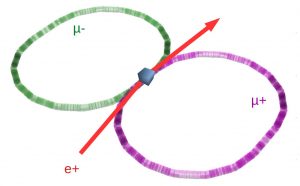
A muon collider is one of the best solutions for a future machine at the energy frontier because it can provide, still using elementary particles, a center of mass energy much higher than any electron collider. However, it has to face several challenges, e.g. the short muon lifetime of 2.2 $\mu$s and the emittance cooling when the muon beam is produced from protons [1].
The LEMMA (Low EMittance Muon Accelerator) project [2] aims to study the possibility of producing muons at low emittance, therefore, not requiring cooling. Profiting from the e+ e– annihilation process into muon pairs, the LEMMA project foresees to use a high intensity and low emittance positron beam, above the production energy threshold at 43.7 GeV, that impinges on a fixed target. An initial experimental test program started in 2016 and continues up to date.
Due to the asymmetry of the collision, the muon lifetime is extended to 440$\mu$s. The resulting muon beam has a low transverse and longitudinal emittance, however, with a small intensity because of the small production cross section.
In order to overcome the low muon population, LEMMAACC is studying the magnets optics and beam dynamics of a muon ACCumulator ring for LEMMA that stores the muons produced over a hundred to a thousand passages of the positron bunches through the target, therefore, increasing the muon beam population with minimal emittance growth.
The muon accumulator itself shows several challenges. It must have a very small circumference to avoid the muon beam losses due to decay, a large dynamic aperture of +/-20% in order to capture all muons produced, a low beta interaction region common to three beams (e+, $\mu$+, $\mu$–) at two different energies (e+ at 45 GeV and $\mu$ pairs at 22.5 GeV) where the target is allocated.
More detailed info is available in the following links:
[1] The Muon Accelerator Program: https://map.fnal.gov/[2] LEMMA project: https://web.infn.it/LEMMA/index.php/it/
 INFN-LNF Laboratori Nazionali di Frascati
INFN-LNF Laboratori Nazionali di Frascati